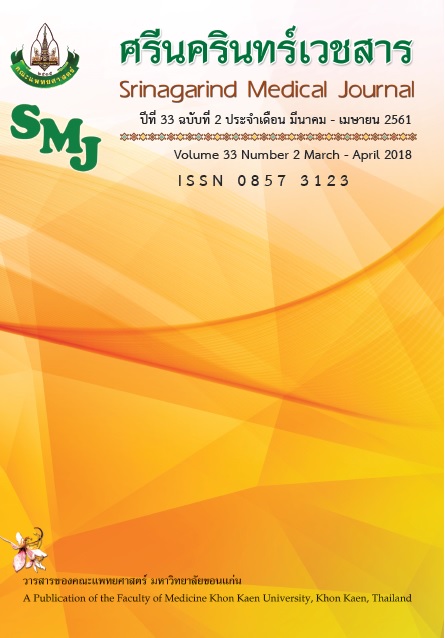Post-operative Analgesic Efficacy of Single Injection of Bupivacaine on Iliac Crest Bone Harvesting Donor Site after Anterior Cervical Spine Fusion
Keywords:
OrthopaedicAbstract
Background and Objective: Autogenous iliac crest bone grafting inspinal fusion leads to post-operative pain at the donor site. The objective of this study was to compare the post-operative analgesic efficacy between single injection of bupivacaine and placebo at anterior iliac crest donor site after anterior cervical spine fusion.
Method of study: This study is a randomized triple-blinded control trial in 35 patients who had anterior cervical spine fusion at Srinagarind hospital between 2012-2014. Patients were randomly allocated into 2 groups using block of four randomization. Eighteen patients in treatment group; received single injection of 0.5% bupivacaine 10 ml while 17 patients in control group received normal saline solution 10 ml. The primary outcome was the post-operative numerical rating pain score (NRS) at 6, 12 and 24 hours whereas the post-operative morphine consumption and duration of hospital stay were evaluated as secondary outcomes.
Results: The post-operative mean difference of NRS at 6 hours and overall 24 hours were statistically significant lower in the treatment group (1.37 and 0.88 points, p=0.035 and 0.036respectively). The mean difference of post-operative morphine consumption at 24 hoursvia PCA device (1.65 and 0.37 mg, p-value = 0.44 and 0.86) and the duration of hospital stay (0.13 day, p=0.77) were not difference in both groups. Complication was not occurred in both groups.
Conclusion: A single injection of bupivacaine at the iliac crest bone graft donor site reduce post-operative painscore at 6 hours and the overall pain score within24 hours without the complication. No significance different on post-operative morphine consumption or duration of hospital stay.
ผลการระงับปวดหลังผ่าตัดของการฉีดยาชา bupivacaine ครั้งเดียวที่แผลผ่าตัดกระดูกปลูกถ่ายเชิงกรานในการผ่าตัดเชื่อมกระดูกสันหลังระดับคอด้านหน้า
เกรียงไกร วิทยาไพโรจน์1*, อุ้มจิต วิทยาไพโรจน์2, กิตติพงษ์ วิทยาไพโรจน์1
1ภาควิชาออร์โธปิดิกส์ 2ภาควิชาวิสัญญีวิทยา คณะแพทยศาสตร์ มหาวิทยาลัยขอนแก่น 40002
หลักการและวัตถุประสงค์: การใช้กระดูกปลูกถ่ายจากเชิงกรานเพื่อเชื่อมกระดูกสันหลัง ทำให้ปวดแผลกระดูกปลูกถ่ายได้มาก การศึกษานี้มีวัตถุประสงค์เพื่อเปรียบเทียบผลระงับปวดระหว่างยา bupivacaine และยาหลอกฉีดครั้งเดียวที่แผลกระดูกปลูกถ่ายในผู้ป่วยผ่าตัดเชื่อมกระดูกสันหลังคอด้านหน้า
วิธีการศึกษา: เป็นการศึกษาสุ่มปกปิดสามทางในผู้ป่วยผ่าตัดเชื่อมกระดูกสันหลังคอด้านหน้า ที่โรงพยาบาลศรีนครินทร์ ในพ.ศ. 2555-2557 จำนวน 35 ราย แบ่งผู้ป่วยเป็นสองกลุ่มโดยการสุ่มแบบ block of 4 เป็นกลุ่มรักษา 18 ราย ได้รับยาชา 0.5% bupivacaine 10 มิลลิลิตร และกลุ่มควบคุม 17 ราย ได้รับน้ำเกลือ10 มิลลิลิตร ฉีดครั้งเดียวที่แผลผ่าตัดกระดูกเชิงกราน วัดผลการศึกษาหลักคือคะแนนความปวด(NRS)ที่กระดูกเชิงกรานหลังผ่าตัด6, 12 และ 24 ชั่วโมง และวัดปริมาณการใช้ยามอร์ฟีนหลังผ่าตัดและระยะเวลานอนโรงพยาบาลเป็นผลการศึกษารอง
ผลการศึกษา: กลุ่มรักษามีคะแนนความปวดหลังผ่าตัดที่6 ชั่วโมงและความปวดรวมใน 24 ชั่วโมงน้อยกว่ากลุ่มควบคุมอย่างมีนัยสำคัญทางสถิติ (1.37 และ 0.88 คะแนน, p=0.035 และ 0.036 ตามลำดับ) แต่ไม่พบความแตกต่างของปริมาณการใช้ยามอร์ฟีนหลังผ่าตัดที่ 24 ชั่วโมงและปริมาณยามอร์ฟีนที่ใช้ทั้งหมด(1.65 และ 0.37 มิลลิกรัม, p= 0.44 และ 0.86) รวมถึงระยะเวลานอนโรงพยาบาล (0.13 วัน, p=0.77) และไม่พบภาวะแทรกซ้อนในผู้ป่วยทั้งสองกลุ่ม
สรุป: การฉีดยาชาbupivacaine ครั้งเดียวที่แผลกระดูกเชิงกรานสามารถลดความปวดหลังผ่าตัดที่ 6 ชั่วโมงและความปวดรวม 24 ชั่วโมงได้โดยไม่เกิดภาวะแทรกซ้อน แต่ไม่มีผลต่อการใช้ยามอร์ฟีนหลังผ่าตัดและระยะเวลานอนโรงพยาบาล




